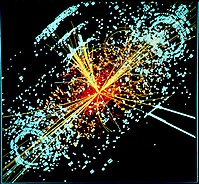
Photo from wikipedia
Abstract In a theory of quantum gravity, states can be represented as wavefunctionals that assign an amplitude to a given configuration of matter fields and the metric on a spatial… Click to show full abstract
Abstract In a theory of quantum gravity, states can be represented as wavefunctionals that assign an amplitude to a given configuration of matter fields and the metric on a spatial slice. These wavefunctionals must obey a set of constraints as a consequence of the diffeomorphism invariance of the theory, the most important of which is known as the Wheeler-DeWitt equation. We study these constraints perturbatively by expanding them to leading nontrivial order in Newton’s constant about a background AdS spacetime. We show that, even within perturbation theory, any wavefunctional that solves these constraints must have specific correlations between a component of the metric at infinity and energetic excitations of matter fields or transverse-traceless gravitons. These correlations disallow strictly localized excitations. We prove perturbatively that two states or two density matrices that coincide at the boundary for an infinitesimal interval of time must coincide everywhere in the bulk. This analysis establishes a perturbative version of holography for theories of gravity coupled to matter in AdS.
Journal Title: Journal of High Energy Physics
Year Published: 2022
Link to full text (if available)
Share on Social Media: Sign Up to like & get
recommendations!